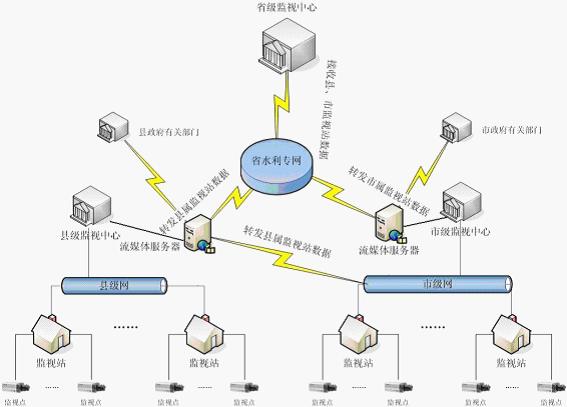1、 Meaning
2、 Monitoring target
3、 Architecture
4、 Network channel
5、 Functional requirements
5.1. Electronic map
5.2. Linkage with water conservancy database
5.3. Picture publishing function
5.4. System interconnection interface
6、 Technical indicators
6.1. Video technical indicators
6.2. Audio technical index
6.3. Network indicators
6.4. Storage index
7、 Environmental requirements
7.1. general requirements
7.2. Night monitoring requirements
7.3. Lightning protection requirements
8、 Follow up work
8.1. System access and interworking specification
8.2. Linkage of water conservancy plan
8.3. Expansion of intelligent system
1、 Meaning
Water conservancy informatization is the basic symbol and important content of water conservancy modernization. It is the concrete embodiment of the national idea of transforming and upgrading traditional industries with informatization in the water conservancy industry. It is one of the important measures to drive water conservancy modernization. With the development of water conservancy informatization, the water conservancy industry has successively implemented water conservancy video monitoring projects in recent years, which provides intuitive and effective management means for flood control and water resources management. However, due to the decentralized construction of these systems, there are problems such as different architectures, diverse equipment and mutual incompatibility, which has brought many problems to the development of water conservancy video monitoring system in the direction of watershed and networking. Often at the critical moment of flood control, due to the compatibility of the system, decision-makers can not remotely observe the real-time situation of each built monitoring point in the watershed, In order to solve the above problems, there is an urgent need for a set of video monitoring standards for water conservancy basins to standardize and implement each video monitoring system, so as to make the function system easy to be compatible and easy to expand. On the basis of summarizing the experience of provincial land system construction, the Provincial Department of water resources puts forward the video monitoring standard of water conservancy industry. The standard standardizes the technical requirements of video monitoring system of water conservancy industry in combination with the characteristics of the industry, and tries to make the subsequent monitoring systems realize interconnection and interworking under the standard framework. This paper intends to discuss some key issues in the standard in order to promote the standardization and standardization of video surveillance in water conservancy industry.
2、 Monitoring target
The water conservancy video monitoring system shall reasonably select the monitoring points according to the characteristics of different monitoring objects such as reservoirs, gate stations, seawalls, flood diversion and detention areas and important flow measurement sections, taking into account flood control and project management. The layout of monitoring points shall meet the effective observation of the following monitoring objects:
Reservoir: dam, spillway, sluice gate, spillway tunnel and water level gauge;
Gate station: main body of gate station building, gate, upstream (downstream) water area, embankment and water level gauge;
Embankment: embankment top, pavement and nearby waters;
Flood diversion and detention area: flood diversion gate and blasting point;
Important flow measurement sections: water area and water level gauge;
Safe haven: water area.
Among the above monitoring targets, the water gauge is a key monitoring target. The camera shall be able to clearly observe the scale of the water gauge when the light is on during the day and night.
3、 Architecture
The water conservancy video monitoring system consists of monitoring centers and stations at all levels. Monitoring centers shall be set up in provincial, municipal, county (city, district) water conservancy departments and flood control command centers respectively, and monitoring stations shall be set up in water conservancy project management and other units. The monitoring center and monitoring station are connected through computer network to form a multi-layer and multi node mesh node

L the monitoring station is directly connected with one or more front-end monitoring points to collect real-time images and other relevant data information of the front-end monitoring points, and manage and store them. In this case, the general monitoring stations are the direct management departments of large and medium-sized water conservancy projects.
L the monitoring center controls, monitors, manages and accesses all image information of monitoring stations within its jurisdiction, and releases real-time working condition image information to the public.
The municipal and county (city, district) level monitoring centers are equipped with video streaming media servers to provide image information to relevant government departments at the same level and higher-level monitoring centers.
The provincial monitoring center controls, monitors, manages and accesses the images of monitoring stations in the province according to the actual needs through a unified network monitoring and management platform.
This architecture is suitable for the requirements of river basin monitoring and is the mainstream direction of future development. It fully reflects the characteristics of river basin monitoring. At the same time, it ensures that leaders and decision-makers at all levels can obtain real-time video information through the network system at the time of flood control.
4、 Network channel
In general, the water conservancy private network can be used to realize video transmission, but considering the large video code stream, it is recommended to rent an independent network channel for video transmission, which should be interconnected with the water conservancy private network. The network from each monitoring station to the city and county monitoring center in the above structure diagram can be rented. With the permission of funds, Huzhou water conservancy construction scheme can be adopted to directly transmit analog video to the center with optical fiber, and the optical fiber can be laid in the way of rent and purchase. In some cases where the channel is poor or the conventional channel cannot be reached, the wireless channel can be used.
5、 Functional requirements
In addition to the basic functions of ordinary monitoring system and camera rotation, the water conservancy video monitoring system should also highlight the following functions
5.1 electronic map
Because the business system of water conservancy industry mostly adopts the way of electronic map driving to realize various operations, it is recommended to combine geographic information system (GIS) in the video monitoring system to realize the operation and interface of electronic map based on vector mode.
5.2 linkage with water conservancy database
The role of simple video monitoring system is relatively limited. If it is combined and linked with the water conservancy database, it can master the information of water, rain and work conditions in real time while monitoring, which will play a significant role in promoting the correct decision-making of flood fighting and disaster relief.
It is suggested that while monitoring the real-time video, the system can obtain the water, rain and work conditions information of the existing gate and reservoir through the standard real-time water, rain and work conditions database structure. At the same time, it can realize the effective linkage of water and rain conditions, work conditions information and video information. For example, when the water level exceeds a warning value, the linkage video can realize the alarm, which is convenient for leaders and relevant personnel to make decisions in time.
5.3. Picture publishing function
The system shall have the function of picture publishing, take screenshots of real-time monitoring images, generate pictures, upload them to the server and publish them through the network. Since most of the targets in the field of water conservancy monitoring are slow changing targets, such as the rise of water level, the opening of gate, etc., the frame rate can be appropriately reduced on the premise of ensuring the video definition, so as to reduce the code stream. In most cases, the monitoring in the form of picture (1 frame / s) can also meet the requirements.
5.4 system interconnection interface
The system shall provide corresponding interconnection secondary development interface for other business systems or upper system access, mainly including video transmission, video decoding and general command interface.
6、 Technical indicators
6.1 video technical indicators
MPEG-4 / H.264 is recommended as the encoding and decoding standard;
The subjective definition of video shall be more than 4 points and the resolution shall be D1 (704 x 576). At this time, the code stream shall be controlled below 1m.
Adjustable video frame rate: pal: 1 / 16 ~ 25 frames / second; NTSC: 1 / 16 ~ 30 frames / second adjustable;
Video output bit rate: 32K ~ 2m per channel, adjustable.
6.2 audio technical indicators
In the water conservancy video monitoring, audio modules can be added appropriately. If illegal entry into the water area is found through video, you can shout to remind, and the audio quality at this time is required to be equivalent to that of ordinary telephone.
6.3 network indicators
It shall support TCP, UDP, RTP, multicast and other means to transmit compressed code stream, and can support the network to browse any one or more video images in real time, view the operation status of video equipment, and control and operate the equipment at the front-end monitoring point;
It shall support PPPoE protocol broadband dial-up access to the Internet and DNS;
DHCP protocol shall support automatic acquisition of IP address;
Real time video delay shall not exceed 0.5 seconds;
Each server for forwarding supports at least 60 channels of D1 real-time video data stream concurrent network transmission, and each channel of code stream is about 1m.
6.4 storage index
The equipment used for storage shall meet the following indicators:
It supports more than 8 built-in hard disks and supports the storage of each channel of image and video data at D1 resolution for more than 1 month (including one month). SATA interface hard disk should be used;
Support the function of asynchronous startup and protection of hard disk;
Support video status detection;
Support hard disk fault early warning (smart self detection, analysis and Reporting Technology) and hard disk fault alarm.
7、 Environmental requirements
Water conservancy video monitoring projects are often built in the field with harsh weather conditions, especially in the flood fighting and disaster relief time when the system is most frequently used, there are often severe weather conditions such as strong wind and heavy rain. The selected cameras and other outdoor equipment must be able to be used in harsh environments such as rain and corrosion prevention. The requirements of typhoon resistance must be considered for supports and poles. The main requirements are as follows
7.1 General requirements
The camera bracket, pole and PTZ can work normally when the wind force is 12, and there is no obvious shaking in case of strong wind, which does not affect the viewing effect of video.
Due consideration shall be given to the characteristics of high humidity around the water area and high salt content in the water vapor at some sea inlets. The selected equipment shall consider the problems of salt fog prevention, corrosion prevention, rust prevention, deformation prevention and so on.
Most water conservancy projects are in the wild and easy to become the target of theft. Therefore, the requirements of anti-theft and anti smashing should be fully considered during construction.
The protection grade of outdoor protective cover shall not be lower than IP65.
7.2 night monitoring requirements
In the existing water conservancy projects, many lighting systems are not installed, and the night is often the key time of flood fighting and disaster relief. Therefore, the requirements of night monitoring should be fully considered in the system design, and two methods of spotlight lighting or infrared can be adopted,. It is recommended to give priority to spotlight lighting mode. Night monitoring shall meet the following requirements
When the auxiliary lighting device is turned on, the effective illumination projected to the monitored area shall not be lower than that of 40W incandescent lamp.
The effective monitoring distance of infrared camera shall be determined according to the actual situation, and the outdoor shall not be less than 30m.
7.3 lightning protection requirements
Water conservancy projects are often built in open places in the field, which are easy to be attacked by lightning. The power supply of the equipment at the monitoring point is generally taken near the site, and it is also easy to be affected by lightning waves to produce high voltage and surge current. In order for the equipment to operate reliably and for a long time, the camera rod and front-end chassis must be grounded; The video signal of the camera shall be equipped with lightning protection equipment to prevent the damage of lightning to the camera and other equipment; Each monitoring station shall be equipped with power surge protector to prevent the invasion of lightning.
8、 Follow up work
The formulation and implementation time of this standard is relatively short. Compared with the standards of electric power and public security industries, there are still many areas that need to be improved. The following work will be carried out in the next stage.
8.1 system access and interworking specifications
The existing standards only require the interface of open system access and interworking, but they are not standardized. It is difficult to interworking. In the next stage, it is considered to formulate corresponding interface specifications according to the public security mode to unify data transmission, video decoding and command interface.
8.2 linkage of water conservancy plan
In flood control and flood fighting, the plan plays a key role. Combining the existing video monitoring system with the plan and linking it with the plan will greatly promote its effectiveness. In the early projects in Huzhou and Hangzhou, a preliminary attempt has been made to link the water level alarm and video, which has played a certain role. The standardization work in the next stage will further improve this part of the work.
8.3 expansion of intelligent system
In the existing water conservancy video monitoring system, it mainly relies on manual analysis of emergencies and concerns, which is prone to missed judgment and misjudgment. At the same time, with the development of video monitoring system, the scale of the system is becoming larger and larger, and the amount of data stored and contained in the video system is often in TB, forming a real massive amount of data, The workload of analysis and processing of water conservancy department staff is greatly increased, which affects the application efficiency of the system. In the next stage, some commonly used intelligent algorithms can be gradually recommended in the standard, such as ruler scale analysis, gate opening state analysis, warning line analysis of no swimming area and other algorithms. Such algorithms will be combined into the existing video monitoring system through the standard.

 Manager Wang
Manager Wang
 OfficialAccounts
OfficialAccounts